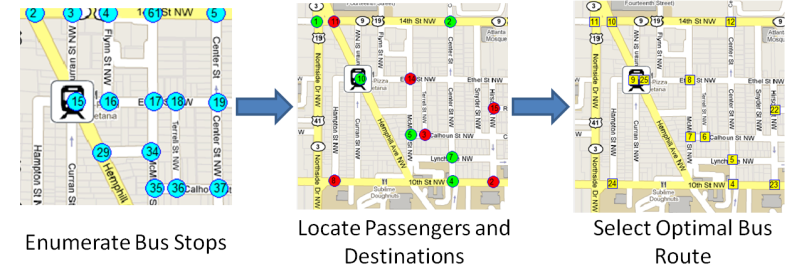NITS FAQ
What is The Network-Inspired Transportation System (NITS)?
The NITS is an intelligent system which optimizes the use of a city-wide or regional-wide network of busses, shuttles, vans, rail, bus rapid transit (BRT), and personal vehicle to rapidly transport mass transit riders while minimizing expenses for the transit operator. The NITS receives ride requests from customers and coordinates between all the available modes of transit to ensure rapid, economical, and personalized routing of the passenger.
The system will improve the riding experience for the mass transit passenger and reduce operating cost for the transit operator.
How does the NITS work?
The customer will send a request to a central dispatcher via telephone, text message, website, smart phone application, or on-street kiosk specifying a pick-up location and a drop-off location. The passenger may also specify the type of vehicle (e.g. bus/shuttle or taxi). The automated central dispatcher will then calculate which vehicle to dispatch to the rider and decide the optimal route for that vehicle to take. The vehicle and route chosen is determined by a trade-off between waiting/ride time for the passenger and cost to the NITS operator.
If the vehicle chosen is a bus/shuttle and the trip is within the same neighborhood or adjacent neighborhoods, the bus will provide door-to-door service to the passengers without the need of a transfer. If the trip is a longer trip across several neighborhoods or between cities, the optimal route selected will require a transfer at a rail/BRT station and subsequent transfer to another bus/shuttle. For these types of trips the bus/shuttle system will use knowledge of the real-time schedule of the high speed rail/BRT to ensure quick transfer times. Long wait times for transfers will be non-existent.
If the vehicle chosen is a taxi, then the trip will be a door to door trip without the need to transfer between busses or trains.
How much will the NITS cost to operate and use?
For the System Operator
To the organization operating a NITS service, the cost will be lower than operating a traditional bus/train transit system. This is because the NITS reduces waste from using busses that are too large or too small for the job and reducing waste by only running busses on routes where there is rider demand.
For the Passenger
This goal of the NITS is to provide service with less economical overhead than a traditional transit system. Due to this, the price of riding a bus/shuttle will remain approximately the same as riding a traditional transit system. Likewise, selection of taxi service will be similar to current taxi costs except service will be more expedient due to automated routing and there will be opportunities to share rides with other taxi users traveling along the same route therefore reducing the cost of the ride.
How will the NITS improve the mobility of its users?
The NITS will improve the mobility of its users by providing each user with a personalized itinerary that reduces time waiting for the bus/train to arrive, time waiting for transfers and time spent riding the bus/train. This system also removes the control of the bus schedule from the system operators and places that control in the hands of the passenger. The passenger decides when and where he or she wants to travel and the onus is on the optimization system to meet the demands of the customer. This is in contrast to the system telling the passengers when and where the busses will be traveling and the onus is on the customer to ensure that his or her schedule conforms to the predetermined bus schedule.
How will the NITS improve the transportation experience of non-users?
The NITS will greatly improve the efficiency of public transportation systems. In doing so, the need to drive a personal automobile will be offset by the availability of the buses in the NITS system. Therefore, fewer automobiles will be on the roads leading to reduced congestion for automobile drivers and safer walking conditions for pedestrians. Trained, professional drivers will replace the average automobile drivers, leading to safer conditions for vulnerable road users such as bicycles and motorcycles. Furthermore, removing a significant number of single occupancy vehicles from the network will lead to a marked reduction in vehicle emissions, traffic noise, and demand for petroleum.


Leave a comment